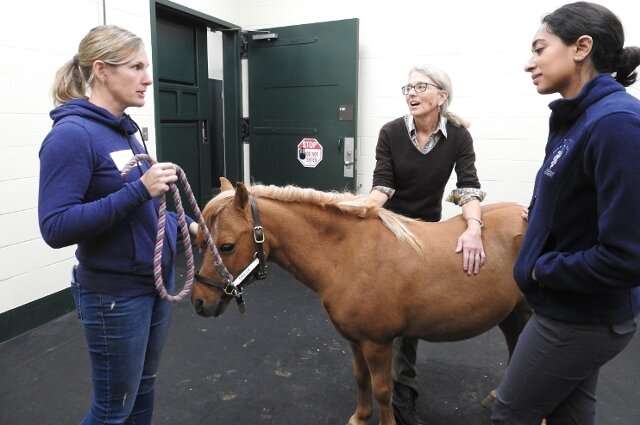
by Genevieve Rajewski, Tufts University
Pixie, a thirteen-year-old Shetland pony, is only about one-fifth the size of most horses seen for asthma at Tufts Equine Center. That doesn't make his breathing problems any less significant, though.
In the year and a half since Pixie was adopted, his asthma attacks—in which his sides heave from desperately trying to draw each breath—have become more common and severe. "It's awful," said owner Sara Smith, whose three-year-old daughter loves being led around on the gentle gelding's back. "Once the heaves start, it's just so uncontrollable."
Cummings School veterinarian Melissa Mazan, V93—who is caring for Pixie as part of a clinical trial evaluating a possible new treatment for equine asthma—stroked the sorrel pony's nose and nodded sympathetically. She has been working on the challenging condition of equine asthma for her entire professional career, and knows how hard it hits the horses and their owners.
"We have learned a lot about how to diagnose equine asthma and its molecular mechanisms, but we treat this condition almost exactly like we did when I started out more than twenty years ago," Mazan said. "And anyone trying to treat an asthmatic horse often ends up stuck between a rock and a hard place."
Bronchodilators—the medications delivered by rescue inhalers to treat asthma attacks in humans—relax the airway, making it easier for asthmatics to breathe. But humans—and horses—can quickly develop a tolerance to these drugs, so these treatments must be used sparingly to preserve their ability to work for the most acute asthma attacks.
For this reason, corticosteroids, which reduce the inflammation that fuels asthma, do most of the heavy lifting when it comes to treating affected humans and horses. "Inhaled steroids—you know, the puffers—have been a game-changer in human asthma," said Mazan. "They have been in equine asthma as well, but they are sickeningly expensive."
Inhaled steroids can cost as much as $300 a week for horses. "You've got to have pretty deep pockets to afford that," Mazan said. Many horse owners must choose a less-expensive option: oral or injectable steroids. These get absorbed into the bloodstream, though, and can cause serious side effects throughout the body. That's particularly true in aging horses with coexisting metabolic disease, such as poor wound healing and liver dysfunction.
Mazan routinely reviews scientific publications on human asthma, searching for new equine treatment ideas. One day, she found a study looking at whether a local anesthetic called lidocaine could treat people with intractable cough—coughing so bad that it can break a rib or collapse a lung.
This article originally appeared in it's entirety on on PHYS.org, This excerpt is published here with permission.
Find out more about important health issues in our section on Health & Education.

































